![]()
![]()

![]()
![]()
L e n s V i e w sA view from the Blu (-ray) on DVDBeaver by Leonard Norwitz |
|
Modus Operandi The Scorecard: Emotive Connection Audio Operations Extras The Movie Equipment
BLU-RAY STORE ALL OUR NEW FORMAT DVD REVIEWS
|
|
Planet of the Apes 40th Anniversary Collection [Blu-ray] aka: Planet of the Apes 40- Year Evolution Blu-ray Collection
Review by Leonard Norwitz
Theatrical: Apjac & 20th Century Fox Blu-ray: 20th Century Fox Home Entertainment
Discs: Region: A Release Date: November 4, 2008
The Box: At present there are two ways to buy all the Planet of the Apes movies on Blu-ray: individually (@ $34.99 each), or in this deluxe 40- Year Evolution Blu-ray Collection box set (@$139.98). As if to ensure there would be no repeat of the criticism for the flimsy Omen Collection, this Planet of the Apes set is the largest, most substantial, most extravagant packaging I've seen from a U.S. studio. At the heart of this 11.3 x 8 x 1.6 inch box is a 200-page hardbound book of only slightly smaller proportions (10.6 x 7.3 x 0.6 in.) The book, which contains background information, synopses, and production shots and stills form each movie, is completely removable from the box, permitting the remainder to be returned to its sturdy, protective sleeve.
That sleeve is an interesting design in itself in that it allows for an inner sleeve that opens to folds out to a neatly executed 20.5 inch time line that begins with the launch of Taylor's spaceship in January of 1972 and, hitting all the major points of interest through the third, fourth, and last sequel, ends with the triggering of the Alpha/Omega bomb at the end of the first sequel. Open this sleeve once again to its full 46 inches to find the individual discs plus the sleeve that secures the book when replaced into the box.
Except for one nagging difficulty, it's all very commendable: Each disc is held in place, not by a clasp (for to do so would risk scratching the inner surfaces of the sleeve) but by a cylindrical post of a spongy material that is just a wee bit greater in diameter than the hole of the disc. This allows to the disc to be held securely, but it also does its best to prevent an easy replacement once removed.
I have one niggle, which is that the title for the box is written on only one spine, as if to insist on horizontal placement. The bookcases that house all my video are only 7-8 inches deep, which means that either there will be considerable overhang or I have to place the box vertically, which would be fine, except that there is no title on that spine. An oversight, only, but it does indicate a certain detachment from how people are likely to use the actual product.
The Extra Features: Unlike the six-disc DVD Legacy Collection, there is no extra volume that takes care of the essential bonus features. In the case of the Legacy, that disc – titled Behind the Planet of the Apes – was comprised primarily of a two-hour documentary hosted by Roddy McDowall. That feature, along with some new interactive potential, is just one of the huge number of extras on the 1968 movie Blu-ray disc. As for the four sequels, the bonus features are pretty much limited to trailers for the other movies in the series, plus a making-of documentary for that movie. There are no additional commentaries, but each disc does offer an isolated score track and promotional art galleries. Escape from the Planet of the Apes and Conquest from the Planet of the Apes offer a second behind the scenes featurette. These are in SD and of remarkably poor quality, interesting only for their historical importance.
Image Overview: Certainly the 1968 classic gets the most attention from the restoration team. It is the only movie that really looks different in any substantial way from the Legacy DVD that preceded it. I don't happen to share Gary's opinion about the image - I find that the opening and closing scenes, particularly, have troublesome integrity issues – but in general the new Blu-ray is a significant improvement over the DVD. That said, while it doubtless represents what can be done with the movie on video, it is a far cry from what the art form has to offer, especially from the previous decade. (Just wait until we have The King and I or Gigi on Blu-ray!)
The Legacy DVD of Beneath the Planet of the Apes is in slighter better shape than the first movie: a bit flatter, perhaps. The Blu-ray doesn't do for this sequel – or any of the remaining movies – what it did for the original. I would go further to say that Beneath is the movie least improved by going to Blu-ray. From the look of the Blu-ray sequels, I'd say that in all cases the same master was used, with only few additional tweaks, however the usual improvements in resolution, range of color, dimensionality (less in evidence in Beneath than in any of the others) and absence of edge enhancements (which we can see on the Escape and Conquest DVDs) are manifest. Escape is the most TV-like of all the movies in terms of content, production design and image. The Legacy DVD for Escape had boosted black levels and edge enhancement to give the picture more zip, but the Blu-ray returns the image to a subtler, filmlike appearance. It is with this film and Battle that we can sense a palpable reality to the fabrics and leathers of the ape costumes.
Starting with Conquest, things start to get dark and subterranean, which is where high definition usually helps – as it does here. Conquest is, I think, the grainiest of the five films, so it is important for the grain not devolve into noise, for which the DVD applies some DNR. The Blu-ray helps with this and it tends to minimize the tendency for the image to go flat, as it does on the DVD. Sadly, but as expected since the DVD was so good, the best image is granted to the least of the five films: Battle for the Planet of the Apes. This is the only disc whose image I would say is close to demonstration quality, particularly in some of the scenes of the human/ape encampment. One that is consistent with all five films is how poor telephoto shots are. Many of the outdoor scenes suffer in ways that are not expected. This is not the fault of the transfer, so I think we can believe that what we see here is what was shot.
Audio Overview: It's hard to believe that stereo had been around and commonplace in feature films for a dozen years by the time of the first Planet of the Apes movie in 1968, and yet right up to the final installment in 1973, all of these movies were recorded in mono. Just as with the James Bond movies on Blu-ray, Fox has opted to include both the original mono (in some cases in some sort of restored condition) and a 5.1 DTS uncompressed HD Master Audio mix. The success of that mix varies some from movie to movie. I found the dialogue on Conquest to have a kind of hollow feel to it, yet the action sequences were vivid and dynamic. Overall, I found that the HD-MA made for a more engaging home theatre experience. And, unlike the case with the early Bond films on Blu-ray, at no time did I feel that the volume balance between the action pieces and the dialogue-only passages was exaggerated. So, points there, too, for restraint.
Overview of the Series: At the end of the movie, when Taylor brandishes his rifle and tells Dr. Zaius: "Don't try to follow me. I'm pretty handy with this." Zaius replies: "Of that I'm sure. All my life I've awaited your coming and dreaded it."
Zaius' reply and Cornelius' reading from the Sacred Scrolls*, though upstaged by Taylor's final damning realization, is really at the heart of perhaps the best of the end-of-the-world screenplays. (*Beware the beast Man, for he is the Devil's pawn. Alone among God's primates, he kills for sport or lust or greed. Yea, he will murder his brother to possess his brother's land. Let him not breed in great numbers, for he will make a desert of his home and yours. Shun him; drive him back into his jungle lair, for he is the harbinger of death.) Murder – calculated and reflexive, passionate and careless, political and intimate - is in our blood from the beginning, from Cain to the present day, with no let-up in sight. We may or may not have picked up the gauntlet from our evolutionary ancestors, but it appears likely that we must pass it on to those who come after.
Planet of the Apes was released on April 3, 1968, the day before the assassination of Martin Luther King, two months before the murder of Robert Kennedy, and in the midst of the Tet Offensive – the bloodiest phase of America's Vietnam War. Its star, Charlton Heston, was generally associated with iconic movie roles that championed freedom (Moses, Ben-Hur, El Cid). But in this movie Heston is cast as the last cynical apolitical American narcissist – an archetype that, by the end of the film, is turned on its head: Taylor is transformed into a prophet for the end of the world – a self-fulfilling, self-piloting, automatically repeating prophet who, like the River Kwai's Col. Nicholson, has more than a hand in bringing about its own conclusion. I wonder if Heston himself appreciated the paradox that Rod Serling spelled out for him?
These thoughts came to me, Katrina-like, as I realized the coincidence of the release date for Fox's Blu-ray Planet of the Apes five-title set, ironically titled: the Evolution Collection, with our Election Day. We shall see.
Whatever one's politics, we can be certain that the four sequels, storied or screenplayed by Paul Dehn (who was not with credentials himself, helping out with: Zefferelli's Taming of the Shrew, The Spy Who Came in From the Cold, and Goldfinger), represent a devolution of the cinematic art. But, then, how could it be otherwise, given the first movie's credentials: screenplay by Michael Wilson (who wrote or had a hand in: A Place in the Sun, The Bridge on the River Kwai, The Court Martial of Billy Mitchell and Lawrence of Arabia) & Rod Serling (need we say more) and Directed by Franklin Schaffner (who previously worked in television, but soon to direct Patton, Papillon and Boys From Brazil). The ending, in some ways like the closing of the door of the first Godfather film, both invited and warned against a sequel.
Coppola had more than simply better luck, he had Coppola and everyone else associated with the first movie that wasn't killed off, and he had a budget. But Planet of the Apes had lost both its director and its writer. The producer of all five movies (and little else, by the way), Arthur P. Jacobs, knew a good thing when he saw it. Each subsequent movie, which would appear annually beginning in 1970, and was granted increasingly dwindling resources so that, as they say, every dollar can be seen up there on the screen. Unlike Wilmer, the cheaper the suit, the cheaper the patter.
Even so, there's entertainment value, if not art, right up to the last moment. And for all the popularity of the first movie, I feel it is underrated. I'm actually quite fond of the third movie (Escape), even though it feels made for TV, and it's nice to see Ricardo Montalban reappear in the fourth (Conquest). Speaking of reappearances: quick now, which was the only film that did not feature Roddy McDowall?
• Planet of the Apes Directed by Franklin Schaffner Written by Michael Wilson & Rod Serling 1968
Aspect ratio: 2.35:1 Codec: AVC @ 29 MBPS Capacity: 50 GB Audio: English DTS HD 5.1 Master Audio + Original English Mono. Spanish & French mono. Subtitles: English, Spanish, Cantonese, Mandarin & Korean Duration: 112 minutes Chapters: 34
Extras: See Gary's review
The Movie: 8.5Astronauts Taylor, Landon and Dodge wake from hypersleep 2000 years into the future, having crashed into a lake in the middle of a desert, believing they are on a planet orbiting around a distant star. But the discovery of a race of mute humans, hunted by armed, talking apes on horseback places an entirely different complexion on things.
Comment:Have you ever noticed that all of the time covered in the first two movies takes place only during the phase of the new moon? SEE GARY's REVIEW HERE
• Beneath the Planet of the Apes Directed by Ted Post Written by Paul Dehn 1970
Aspect ratio: 2.35:1 Codec: AVC @ 28 MBPS Capacity: 50 GB Audio: English DTS HD 5.1 Master Audio + Original English Mono; Spanish mono; French Dolby Surround. Subtitles: English, Spanish, Cantonese, Mandarin & Korean Duration: 95 minutes Chapters: 24
Extras: • Making-of Featurette: From Alpha to Omega: Building a Sequel – in HD (22:10)
The Movie: 5.5The first sequel picks up after Taylor and Nova leave Zaius and the others at the archeological site. There is an abrupt cut to a relic spacecraft with Astronaut Brent ministering to a rapidly declining Capt. Maddox. Attempting to follow Taylor's mission trajectory, Brent now finds himself going through much of what Taylor did, but in an abbreviated form. He is captured, meets with Zira and Cornelius and when he makes good his escape from Ape City, Brent and Nova (who has become separated from Taylor, now missing) find their way into an underground encampment of mutant bomb worshipers, as the Gorillas march to destroy them.
Comment:Brent (James Franciscus) is not an engaging character: he is impulsive, intense, angry and a little stupid. Zira (Kim Hunter) is petulant. Cornelius (David Watson) is conciliatory. Zaius (Maurice Evans) is curiously reasonable. Ursus (James Gregory is bellicose. Nova (Linda Harrison) is frightened out of her wits most of the time. The mutants are all insidious and hypocritical. There's a single-minded absence of nuance in the first sequel that we don't see the likes of again until the final chapter.
Comparison (CLICK ALL TO ENLARGE)
Cropped
Legacy Edition SD-DVD - NTSC TOP vs. Blu-ray BOTTOM
• Escape from the Planet of the Apes Directed by Don Taylor Written by Paul Dehn 1971
Aspect ratio: 2.35:1 Codec: AVC @ 27 MBPS Capacity: 50 GB Audio: English DTS HD 5.1 Master Audio + Original English Mono; Spanish & French mono. Subtitles: English, Spanish, Cantonese, Mandarin & Korean Duration: 97 minutes Chapters: 27
Extras: • Making-of Featurette: The Secret Behind Escape - in HD (16:04) • Featurette: Don Taylor Directs Escape from the Planet of the Apes - in SD (7:46)
The Movie: 7Just before Earth's final destruction at the end of the previous installment, Cornelius, Zira and the incredibly brilliant Dr. Milo make good their escape in Taylor's recovered spacecraft. They reverse course and end up in our time, which makes for some funny bits when apes dressed as astronauts are picked up out of the sea and celebrated in the media. Once Zira's pregnancy becomes known to Dr. Otto Hasslein, he realizes the implications of a race of talking chimps for mankind's future, and beyond.
Comment:This is the only installment that plays like family entertainment. Even the presumed murder of the baby chimp is so obviously done with a doll and shot from such a distance that you have to squint in wonder that no one is taken in by this ruse. We blush at the chutzpah of the plot device that returns the apes to Earth in Taylor's drowned spacecraft but, after all, isn't just about everything about Planet of the Apes hard to swallow once you look beyond the metaphor? Zira and Cornelius (with McDowell back in costume once again) are amusing until the tables are turned on them. Sal Mineo as Dr. Milo, gets to die violently once again – must be a record of sorts.
• Conquest of the Planet of the Apes (Theatrical & Unrated Versions) Directed by J. Lee Thompson Written by Paul Dehn 1972
Aspect ratio: 2.35:1 Codec: AVC @ 27 MBPS Capacity: 50 GB Audio: English DTS HD 5.1 Master Audio + Original English Mono; Spanish mono; French Dolby Surround. Subtitles: English, Spanish, Cantonese, Mandarin & Korean Duration: 87 minutes Chapters: 21
Extras: • Making-of Featurette: Riots and Revolutions: Confronting the Times (20:42) • Behind the Scenes in SD (13:42)
The Movie: 5The story picks up a few years after the end of the previous sequel with the emergence of the talking ape, Caesar, now an adult, along with his human mentor and protector, Armando. Armando (Ricardo Montalban) had been hiding Zira's and Cornelius' offspring in his circus and at long last comes to the city. There had been an intervening plague that wiped out our pet dogs and cats, so humans got the bright idea to train simians as pets, then graduate them for menial work. Try as they might to maintain their anonymity, Armando and Caesar are noticed. Caesar sees this as an opportunity for rebellion.
Comment:The basic idea is a good one, especially as it reflects the rampant race riots across America, but characters have become increasingly stereotypical – even the apes.
• Battle of the Planet of the Apes Directed by J. Lee Thompson Story by Paul Dehn Written by John & Joyce Corrington 1973
Aspect ratio: 2.35:1 Codec: AVC @ 27 MBPS Capacity: 50 GB Audio: English DTS HD 5.1 Master Audio + Original English Mono; Spanish mono; French Dolby Surround. Subtitles: English, Spanish, Cantonese, Mandarin & Korean Duration: 86 minutes Chapters: xx
Extras: • Making-of Featurette: End of an Epic: The Final Battle in HD (16:34)
The Movie: 4After the rebellion and a little atomic war thrown in for good measure (to make good on Heston's rage) - one little woodland community of men and apes, led by the now non-violent Caesar, try to get along, but are threatened from within by militant gorillas – the beasts! – and an intelligent, if certifiable group of mutant humans hiding in what remains of the city.
Comment:Just when we need for things to get bigger, things get smaller. Smaller and more two-dimensional, if such were possible. The dialogue is listless, and the battle scenes look amateurish. Severn Darden as the mutant dictator is precious, however.
Recommendation: 7 The packaging belies what lurks beneath. There is escapist fun here, even after the first movie. Once you battle your way through to the end, you will indeed feel that you have conquered a world. Leonard Norwitz
|
![]()
![]()
![]()
![]()


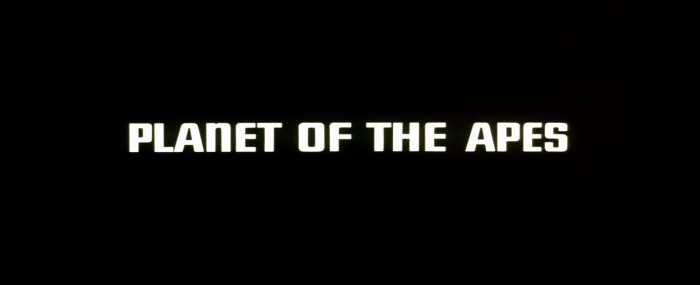
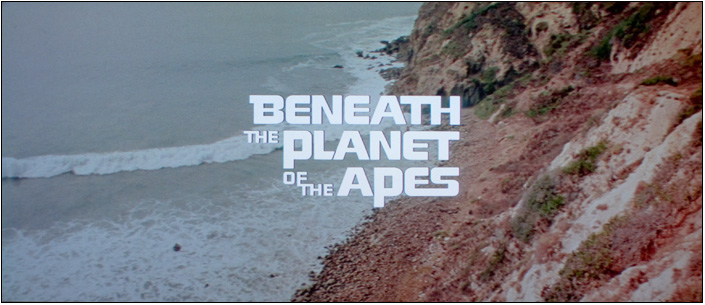
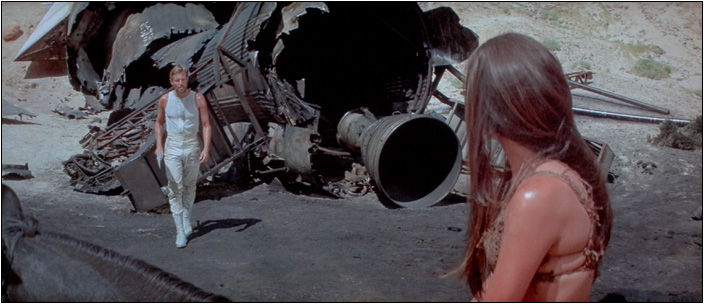
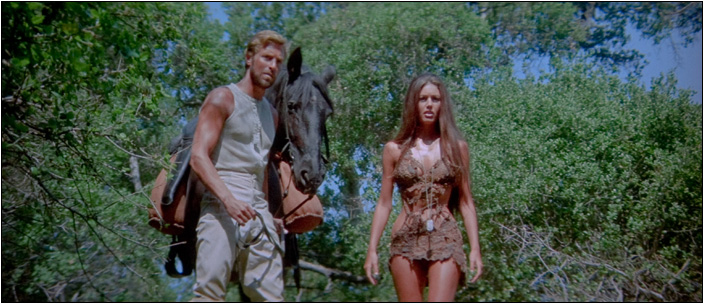
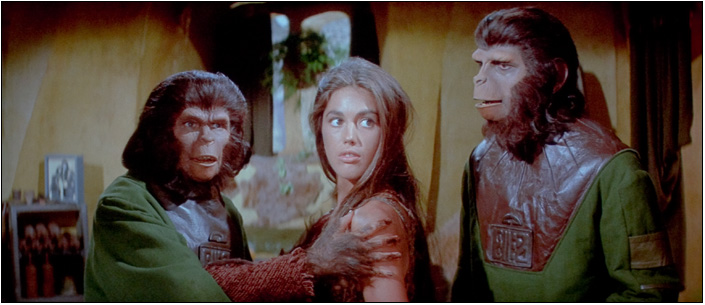
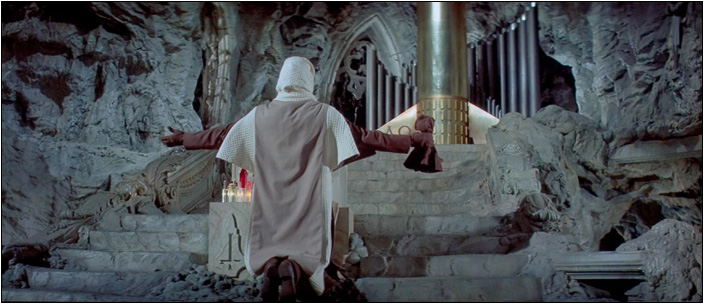
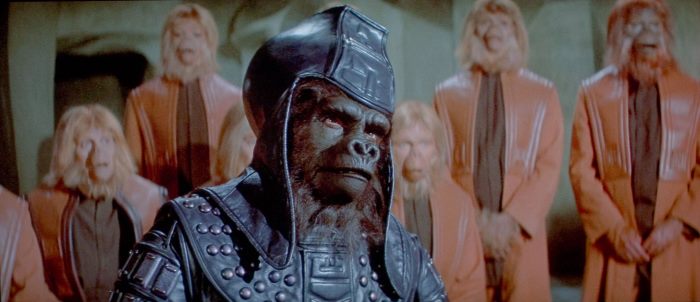
.jpg)
.jpg)
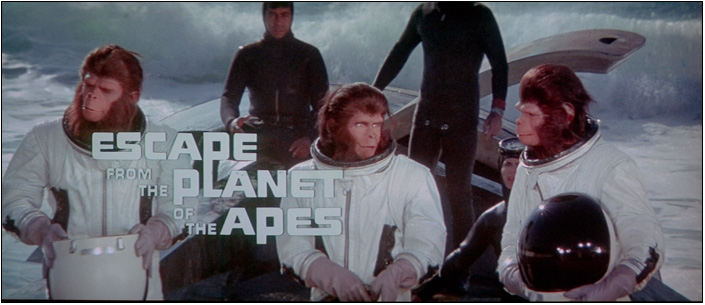
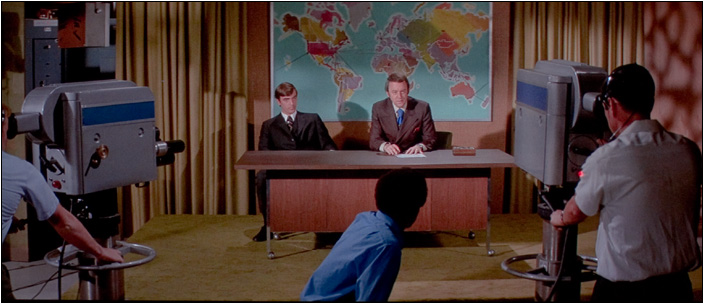
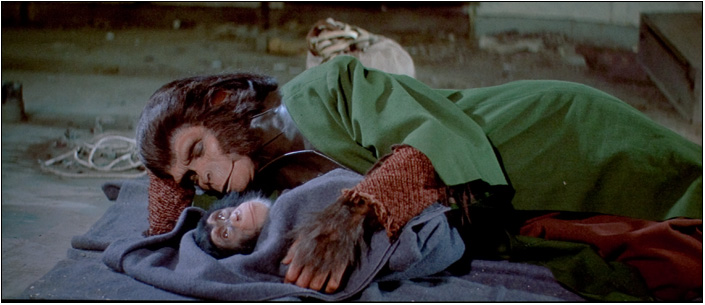
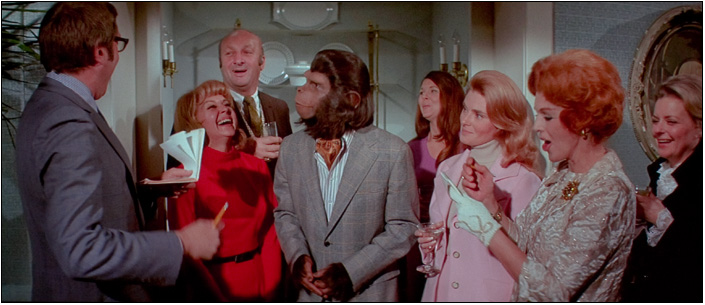
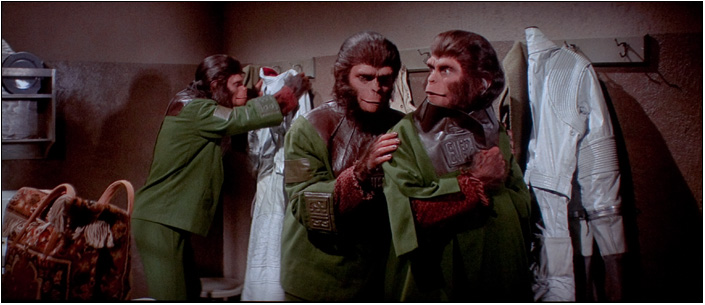
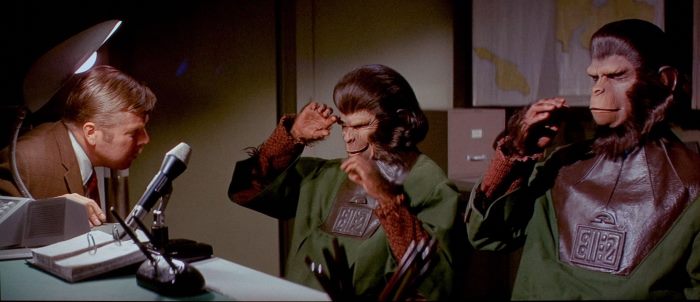
.jpg)
.jpg)
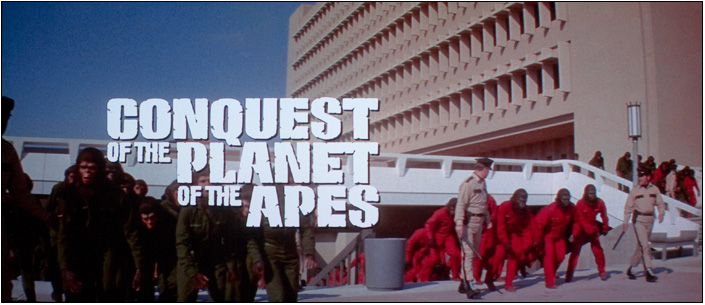
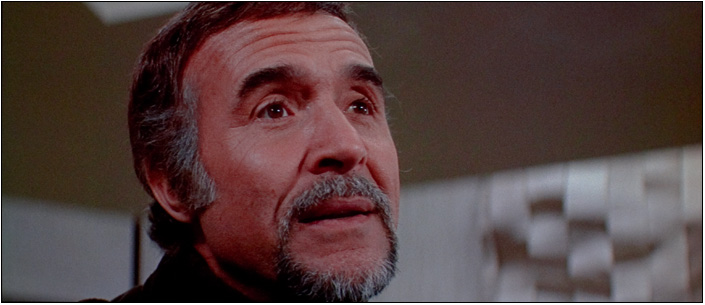
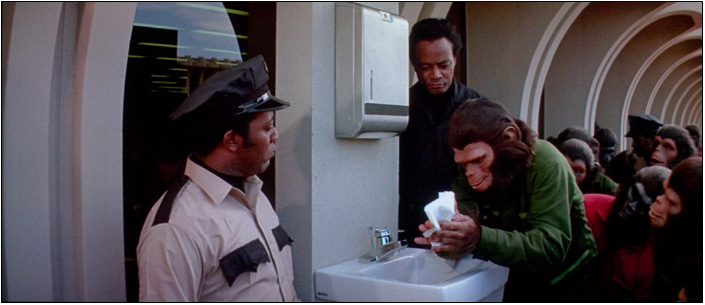
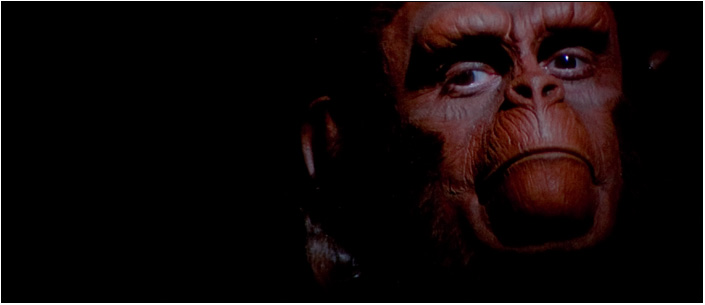
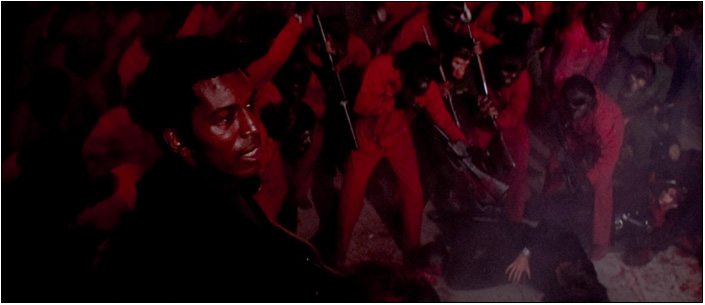
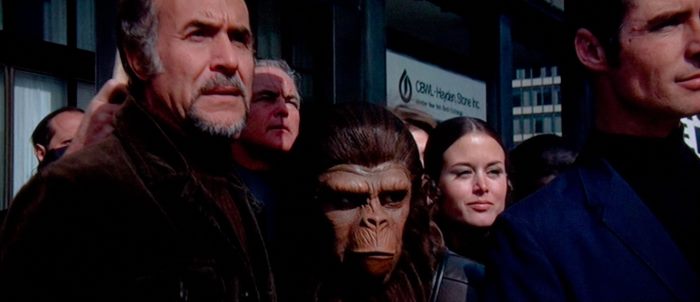
.jpg)
.jpg)
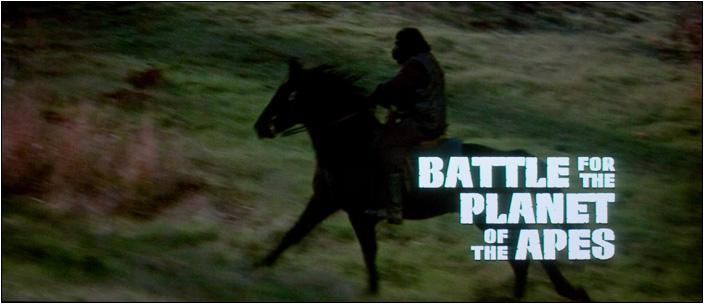
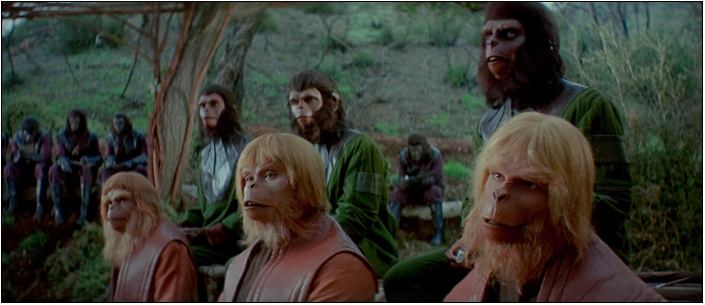
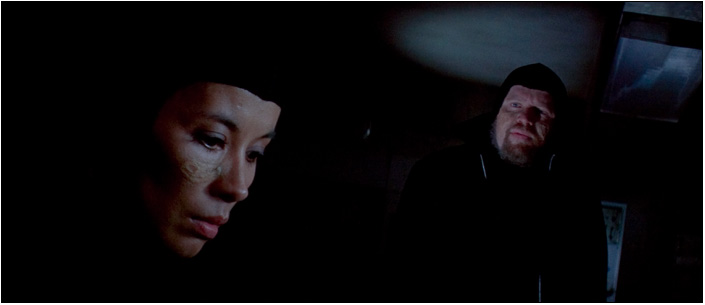
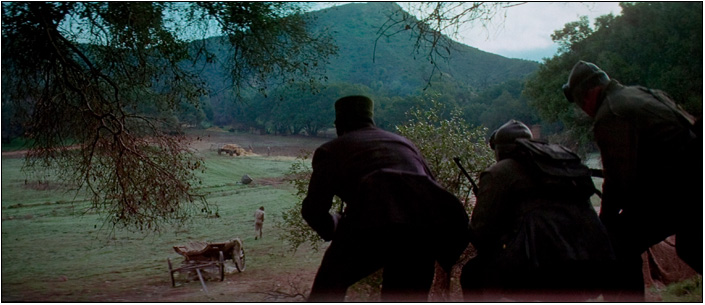
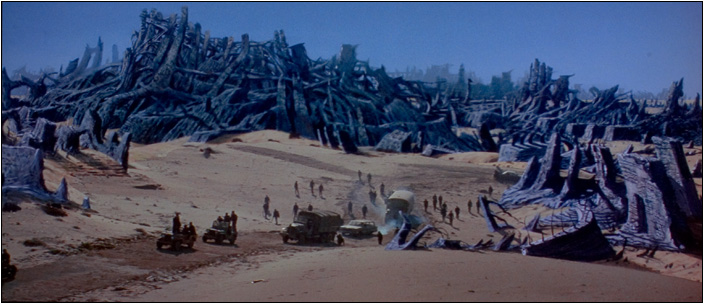
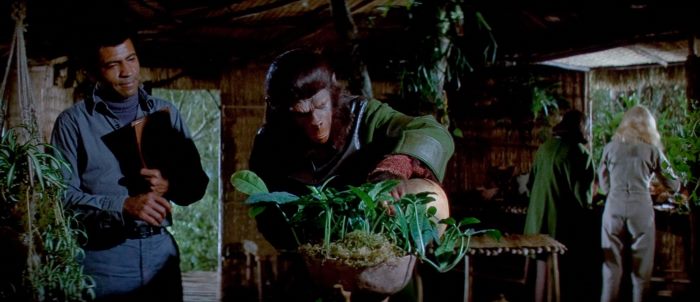
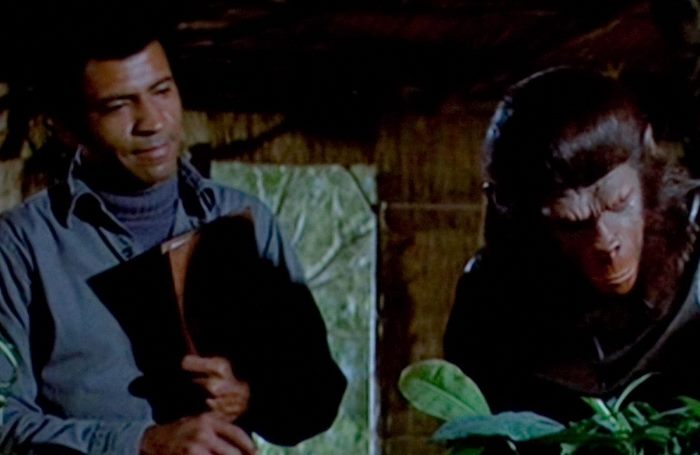
.jpg)

















